You are reading the older HTML site
Positive Feedback
ISSUE
20
july/august
August 2005 - Here are just some hi-res review selections from our August Issue
Grand readings of Tchaikovsky's two big concertos, in grand hi-res surround
MULTICHANNEL DISC OF THE MONTH
![]()
TCHAIKOVSKY: Violin Concerto in D Major, Op. 35; Piano Concerto No. 1 in B-flat Minor, Op. 23 - Christian Tetzlaff/violin Nikolai Lugansky/piano Russian National Orchestra/Kent Nagano - PentaTone Multichannel SACD PTC 5186 022 67:50****:
Alternately spitfire and grand readings from 2003 of two Tchaikovsky staples, with Kent Nagano leading the Russian National Orchestra, itself a virtuoso ensemble organized by Mikhail Pletnev and Vladmir Spivakov. We can thank Balance Engineer Erdo Groot for the mutichannel entries by flute and bassoon as Tetzlaff applies his take-no-prisoners pyrotechnics to the Tchaikovsky D Major Concerto. A rendition of singular focus and poised dynamics, the Tetzlaff performance reminds me of many a streamlined realization from Nathan Milstein, who also drove the figures with a kind of relentless intimacy. Tetzlaff's often rasping tone can dig a bit deeper than some other violinists, again in a manner that takes me back to the bravura style of Guila Bustabo. Maintaining many of Tchaikovsky's often redundant repeats in the Allegro vivacissimo finale, Tetzaff and Nagano make plenty of musical sparks, even while woodwinds do their curlicues in magnificent surround sound.
If Tetzlaff and Nagano apply the afterburners for the Violin Concerto, Lugansky and Nagano take the dreamscape for their model of the Piano Concerto's spacious opening, allowing the piano to bask in the rolling arpeggios and the pizzicati from the strings. Once the tempo is set, Lugansky take the twice-repeated figures (a la Schumann) on a leisurely tour with sporadic bursts of fiery passion. Separation between piano and woodwinds is especially clean and pointed, and the actual piano recording is reverberant without accumulating any ping or wobble in the upper registers. As for Nagano, he has the explosive temperament of Karajan and a warmer sound. His urging of brass and tympani, then the subito to the winds and strings under the keyboard part is quite impressive. Lugansky may well be the natural successor to Lazar Berman, the perfect combination of muscle and poetry, athleticism and polished lyricism. Listen to the crystalline runs in the first movement cadenza and then the block octaves to the finale's rush to judgment in the coda of the last movement! Gary Lemco
The 1978 War of the Worlds audio production, narrated by Richard Burton with a symphonic rock score, remixed for 5.1 surround with a vengeance
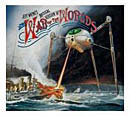
Jeff Wayne's Musical Version of "The War of the Worlds" - The words of H. G. Wells spoken by Richard Burton, with Justin Hayward, David Essex, Phil Lynott - Orch. cond. by Jeff Wayne - Double-disc multichannel 5.1 SACDs - Columbia Legacy C2H 94434, 45:08 & 49:34 **** (Also avail. in 7-disc Collectors' Edition)*:
Obviously tied in with the launch of Steven Spielberg's War of the Worlds (though never mentioning it, and a couple weeks late), this is a hi-res surround with-all-the-trimmings reissue of the unique l978 musical/audio drama/rock opera by Jeff Wayne based on the famous sci-fi novel by the British writer H. G. Wells. The original was a double LP set with 12-inch-square art illustrations. These are reproduced in the sizeable booklet bound with the two CDs, plus a number of other illustrations—such as details of the Martian tripods—not provided originally. The original made quite a splash on both sides of the Atlantic. It won various awards, including being voted the Best Recording in Sci-Fi and Fantasy in l980 by a panel of judges which included Steven Spielberg, George Lucas and Alfred Hitchcock! The work is primarily a symphonic rock suite, with the voice-over narration by Richard Burton speaking what are mainly lines from Well's novel. There are several songs, sung by Justin Hayward of the Moody Blues, Chris Thompson and others. Their lyrics and all the spoken lines are printed in the booklet like an opera libretto. There are also sound effects, including one that sounds like the laser fire in Star Wars.
The music is the sort of thing fans of the Moody Blues and ELO would enjoy. There are some good electric guitar solos and even interesting use of such now-dated electronic instruments as the Mellotron (also popularized by the Moody Blues). A frequent repeated theme used as a transition between sections is a dropping electronic tone which could be a theremin but is probably just a simple tone generator. Vocoder voices are sometimes used as instruments. Some of the tunes are catchy enough to stay with you for some time—aided by the fact they are repeated many times.
The remixing of the original tapes after almost 27 years was said by composer/producer Jeff Wayne to be the highlight of his career. He began with 77 multitrack analog tapes, which turned out to suffer from the sort of aging oxide that required special baking, then transferring to hard disc in the digital domain, before any creative mixing could be done. He rebuilt the original production sound by sound and track by track in a digital equivalent of the original analog 48-track production. This alone took over three months.
His next step was to assemble the four separate CDs of remixes, rarities and outtakes which are offered in the definitive 6-CD + 1 DVD Collector's Edition of War of the Worlds, which also includes a "Making of" documentary video plus a 76 page 12-inch hardback book with many illustrations. The DVD also includes a sneak peak at an animated version of War of the Worlds on which Wayne is currently working. In this premium package the two 5.1 SACDs/CDs are the first two discs, the third is devoted to the best club remixes of the album made since its initial release, and discs 4 to 6 are unreleased tracks and outtakes from the original recording sessions plus the unabridged Richard Burton performance from which only 40% was used in the original album. His narration is much briefer on the original LPs and something else is added to both the stereo and surround remixes: a brief Epilogue in which a NASA mission to Mars triggers a new 21st century War of the Worlds. It doesn't work; falling into that fault of so many feature films in which the final scene ruins the whole thing, It should have concluded earlier.
(While I haven't been privy to the DVD or the book, I was sent the four additional CDs in advance CD-R form. Frankly , one would have to be more of a WOTW freak than the Trekkies at their conventions to appreciate these endless outtakes and other flotsum and jetsam. The voice of the director over the intercom diplomatically suggesting Burton pronounce a word differently, and so forth. There are even versions of his narration in Spanish, French, Portuguese etc.!)
Wayne reported that the end result of the 5.1 remix was in his opinion nothing short of spectacular: "The listener IS in the recording with a Martian invasion in Victorian England happening all around you." He's right. This is a super-sounding surround sound demo from start to finish. Electric guitars emanate from all five speakers and sometimes seemingly overhead. An occasional electronic effect sounds like an electric buzzer with a pitch. There is a very strong low bass beat much of the time in the LFE channel—I had to turn down the level on mine. I'm not used to that since most music hi-res surround doesn't employ the LFE channel. I also had to turn down the surround channels by 2dB because they were overwhelming the front channels (and my speakers are identical front and back). The mix is created with the music often at a high level under Burton's voice and one is forced to play back at rock-concert levels in order to hear the narration clearly. John Sunier
The 2nd PT disc from DTS has DVD-A, DTS & PCM and is A-OK
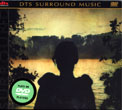
Porcupine Tree – Deadwing; dts Entertainment 69286-01130-9-1 DVD-A ***1/2:
Porcupine Tree has been around since 1993. This is their second release on the DTS label—the first having won the 2004 Surround Music Award for Best Mix: Non-Orchestral (and previously reviewed in this magazine). In addition to the DVD-A track, there is a DTS 5.1 mix and a PCM Stereo track and the surrounds are mainly used for effect with most vocals and instruments residing in the front channels. The press release describes the music as a "unique blend of rock, atmospherics, songwriting and dark intellectual cool." I'd call it modern progressive/alternative rock reminiscent of Rush, Queensryche, Collective Soul, and with early Radiohead-like vocals. Much of the music is ominous and somewhat disturbing still photos accompany every song. The sound quality on this disc is very good—better than most big commercial productions these days. At times it seems there is an excessive amount of treble, but it plays towards the chill of the music. The band truly doesn't fit comfortably into one classification/genre which makes the music more interesting in a way. Track three is a softer Brit-pop style song that sounds a lot like the Lightning Seeds. Some of the tracks are quite long…12 minutes, eight and a half minutes, etc. Just when you think the album is mellowing, songs like track seven come in at full steam with hard thrashing guitar like Rage Against the Machine. All and all it is quite an involving listen and the visuals help drag the listener in deeper.
As extras there is a six and a half minute long short film on the making of the recording. There is also a plentiful photo gallery, lyrics, links, and a trailer for the record. There are three bonus tracks included specially for this release. The first is an instrumental best described as mood music. The second is more rocking, but still instrumental and reminds me of the group Camel. The last has vocals, but is relatively slow—it's like a combination of Pink Floyd with weird, electronic backing. Songs included are: Deadwing; Shallow; Lazarus; Halo; Arriving Somewhere But Not Here; Mellotron Scratch; Open Car; Start of Something Beautiful; Grass arm Shattering. Bonus Tracks: Revenant; Mother & Child Divided; Half-Light. Brian Bloom
Sumptuous spectacle of Brucknerian sound in surround
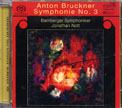
BRUCKNER: Symphony No. 3 in D Minor (1873 Version) - Jonathan Nott/Bamberg Symphony Orchestra - Tudor multichannel SACD 7133 63:11****:
This performance of Bruckner's Third, in its original 1873 version, recommends itself on several counts. First, conscientious editing has restored much of the structural balance, especially in the Finale, that excessive cuts had destroyed. Second, aside from the scholarly and musicological restitutions, Jonathan Nott—of whose pedagogy I scarcely am familiar except that he succeeded Horst Stein as artistic director of the Bamberg Symphony—has mounted a sumptuous spectacle of sound, with an extremely responsive, resonant ensemble whose brass section rises to all occasions. For an audiophile's rush, try the opening of the Scherzo! Given the exalted, sonic quality of the Zurich-based production, the monumentality of the conception, both Bruckner's and Nott's sterling realization, strives for cosmic proportions.
Of course, Bruckner's block-style of composition, with its fits and starts and stops, can either charm or frustrate, depending on the generous gift of one's poetic indulgence. Even with the excision of overt references to Wagner's Ring, there still appear allusions to Tristan and the sleep-motif from The Valkyrie. Those already committed to this score via the efforts of Knapertsbusch, Jochum, and Inbal will likely declare Nott another true Bruckner disciple. He certainly can urge organ-tone richness and delicate, misterioso pianos out of his orchestra. Kudos clearly go to the uncredited Tudor recording engineers, having captured a monolithic sound in a genie's bottle. Gary Lemco
One of the great violinists, in l973 & 75 concerto recordings originally made for quad
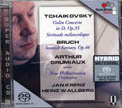
TCHAIKOVSKY: Violin Concerto in D Major, Op. 35; Serenade melancolique, Op. 26; BRUCH: Scottish Fantasy, Op. 46 - Arthur Grumiaux, violin New Philharmonia Orchestra/Jan Krenz (Tchaikovsky) and Heinz Wallberg (Bruch) conductors - PentaTone Multichannel RQR Series SACD 5186 117 71:33****:
PentaTone has entered the sacred chambers of Philips Records, resurrected their stereo and multi-channel (4.0 quadraphonic) archives, here the 1973 Bruch and 1975 Tchaikovsky inscriptions made by the eminent Belgian violinist Arthur Grumiaux (1921-1986)—the aristocrat among the great fiddlers. The Tchaikovsky Concerto is realized with great verve and attention to color details, and the score is given to us nearly complete with repeats, especially in the Allegro vivacissimo finale. The sonic patina possesses richness and depth of field, so that the flute-violin interchange at the opening of the second movement is quite vivid, especially in surround sound. The affecting Serenade melancolique of 1875 communicates intensity without having become maudlin.
Audiophiles will covet the kaleidoscopic color effects of Bruch's Scottish Fantasy, in a magical rendering that is light, lithe, and rife with instrumental niceties of violin, harp, bassoon, and French horn. Based on any number of Scottish folk-melodies, the Bruch piece, too, can easily descend into a cloying mass of sentimentality. Grumiaux, however, projects such a direct sweetness and conviction into the work, eschewing any undue lingering over phrases, that the plastic charm of the work unfolds like an elegant kilt. The rousing finale, a melange of bagpipe, violin, harp, and tutti effects, simply urges one to don a tam and join the dance. PentaTone seems committed to explore this Philips legacy further, to which I say full speed ahead! Gary Lemco
Skilled young Japanese guitarist in a program that probably won't duplicate any of your guitar collection
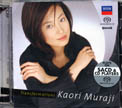
Kaori Muraji, guitar - Transformations - Works of TAKEMITSU, THEODORAKIS, TARREGA, DAVIES, SUMNER & MILLER - Decca multichannel SACD 475 6618 ****:
The young Japanese guitarist has chosen some early works from the many composed for the guitar by the introspective, impressionistic Toru Takemitsu. She also chose some European composers and closes the recital with two by the musician better known as Sting. On these and a couple of the others she is joined by Sting's guitarist Dominic Miller.
Nine of Takemitsu's 12 Songs for Guitar are spread out on the disc, opening with tender arrangements of four Beatles tunes, and later one of Over the Rainbow. Theodorakis, like Takemitsu, is known for his film music but also like his Japanese counterpart he has written works for guitar. The wildly guitaristic Variations on Carnival in Venice is one Tarrega's many guitar pieces I had not before heard; it pulls out so many stops that it begins to sound like two guitars—though Miller does not join Muragi on this track. The first of the two Sting numbers—La Bella Dame sans regrets—is in a bossa nova style and was written as a tribute to Antonio Carlos Jobim.
The guitar sound is extremely present and detailed, and when it is just the solo guitar it never sounds like it is 40 feet wide. Why can't grand pianos be recorded to image the same way? John Sunier
Senior saxes pair up for a friendly alto altercation
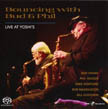
"Bouncing with Bud & Phil" - Live at Yoshi's (Bud Shank & Phil Woods, alto saxes; Mike Wofford, piano; Bob Magnusson, bass; Bill Goodwin, drums) - Capri Records Stereo-only SACD [no number] ****:
Yoshi's Japanese restaurant in Oakland is the best jazz venue in the entire San Francisco Bay Area and bands always look forward to playing there. A number of live recordings have originated from there and from the club's previous location. This one was recorded in November of last year, bringing together LA-based saxist Shank and NYC-based saxist Woods. The combo of a pair of alto saxes is not new; Woods duo'ed with Gene Quill in the 1950s and Shank made some appearances with Art Pepper. Shank and Woods had playing together occasionally over the years and recently were both on a jazz cruise where they really got into their partnership and decided to put together the club appearances and this recording.
Both saxists are in their 70s and have paid their dues many times over. They don't provide a battle of the saxes but a partnership in which they show great respect for each other but have plenty of fun in the process. They were recorded over four nights - the first was getting the technical setup perfected and this disc was selected from the following three nights' highlights. Shank is situated on the left of the soundstage and Woods is on the right. The tracks are all lengthy, with the shortest still over six minutes and one over 14. A standout is their version of Nature Boy.
Tracks: Bouncing with Bud, Helen's Song, Nature Boy, Carousels, Summer Serenade, Gemma's Eyes, Minority. John Henry
Reviews reprinted with permission from Audiophile Audition

